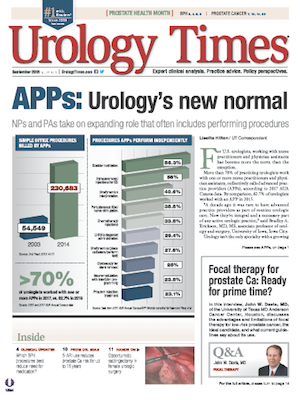Publication
Article
Urology Times Journal
The PA perspective on performing procedures and more
Author(s):
In this Urology Times Q&A, Jessica Nelson, MPAS, PA-C, past president of the Urological Association of Physician Assistants, offers a physician assistant’s perspective on PAs performing urologic procedures, PA training, and more.
In this Urology Times Q&A, Jessica Nelson, MPAS, PA-C, past president of the Urological Association of Physician Assistants (UAPA), offers a physician assistant’s perspective on PAs performing urologic procedures, PA training, and more. Nelson works in the department of urology at UT Southwestern Medical Center in Dallas. She was interviewed by Urology Times Correspondent Lisette Hilton.
What is UAPA’s position on the use of PAs performing urologic procedures?
Currently the board has not taken a stand or published a formal statement regarding PAs performing urologic procedures. PAs legally function under the delegatory authority of physicians. Therefore, PAs can perform procedures within their training and scope of practice if delegated by a physician.
Related - APPs: Urology’s new normal
UAPA members are known to perform cystoscopy (diagnostic, therapeutic, catheter placement, and stent removal); hormone pellet insertions; intracavernosal injections and irrigations; transrectal ultrasound, with or without prostate biopsy; posterior tibial nerve stimulation; bladder Botox injections; circumcision; vasectomy; and first assisting in surgery. UAPA would encourage PA-physician teams to practice in accordance with state law and for the physician to delegate activities that are in their scope of practice and can be safely delegated as determined by the skill of the PA.
Is there interest among urology PAs in practicing independently from urologists?
PAs have never described the goal of the profession to “practice independently” of a physician. In May 2017, the American Academy of Physician Assistants published a policy change describing Optimal Team Practice (www.aapa.org/optimal-team-practice), and the policy emphasizes the PA’s commitment to team practice. UAPA supports the call for physicians and PAs to make practice-level decisions to improve patient access to care and to optimize patient outcomes in light of the challenges facing the specialty regarding adequate work force.
Is urology a popular specialty for PAs?
Looking at the data from National Commission on Certification of Physician Assistants, from the standpoint of all practicing PAs, the most popular specialties for PAs are family medicine/general practice (19.9%) followed by surgical subspecialties, which include orthopedic surgery, cardiothoracic surgery, and neurosurgery (18.5%).
I feel that the lack of exposure to urology as a specialty while in training likely contributes somewhat to the overall lack of large presence of PAs in urology. In addition, the UAPA is actively working towards physician education to integrate PA team members into their clinical practice to extend patient care beyond “routine follow-up cases.”
For example, I personally enjoy (as do my PA colleagues here at UT Southwestern) my ability to function in the outpatient, inpatient, and OR setting with the ability to perform numerous urologic procedures. Lastly, education training is evolving with the development of PA Urologic Fellowships to expand PA breadth of knowledge in urologic care.
Next:"PA education is rigorous and the average program length is 28 months"What do you think urologists might not know about PA training?
PA education is rigorous and the average program length is 28 months. All programs (currently 236) are accredited by the Accreditation Review Commission on Education for the Physician Assistant. Our education is modeled on the medical school curriculum with both pre-clinical instruction and clinical rotations. There are seven required rotations in family practice, internal medicine, women’s health, mental health, pediatrics, general surgery, and emergency medicine, with medicine and surgery elective rotations offered. The mean number of clinical contact hours is 1,993 hours spaced over an average of 51.2 weeks, according to the last Physician Assistant Education Association curriculum survey.
Also see: Is your office-based lab profitable?
All graduate PAs must sit and pass the Physician Assistant National Certification Exam in order to become licensed in any of the 50 states. Lastly, multiple studies have shown that PAs add value to health care teams, provide excellent patient care, and are accepted by the patients they serve.
What is one tip that you think would help urologists better utilize advanced practice providers?
The PA profession does not use the term advanced practice provider to describe the profession and my comments are directed to how urologists can best utilize PAs on the health care team. There is no prescribed standard for which PAs gain urology-specific training. There are some postgraduate programs, which provide vast knowledge and experience, but there are not enough to meet the need and fellowship training is not for everyone. With that said, I would recommend investing the first several weeks, even months of a new PA’s onboarding in urology to be spent side by side with the physician, so they learn not only about urology but also certain practice preferences and standards of patient care. Teach them how to perform procedures, encourage them to read/attend journal clubs or grand rounds if that is an option.
And finally, mentoring is an important component of long-term physician-PA partnership. Of course, encourage their attendance at our annual UAPA conference, which is specifically geared toward PAs and advanced practice nurses in urology, providing both didactic lectures and hands on skills.
To conclude, there are numerous benefits of using PAs to their full scope of practice. They include: increased appointment availability with more timely access to care for patients, increasing work flow efficiency and coordination of care, management of non-surgical patient and those with chronic urologic diseases, care coordination for postoperative patients (for instance post-prostatectomy patients regarding incontinence and sexual function rehabilitation), follow-up care and cancer survivorship programs for oncology patients, and participation in clinical trial research.























